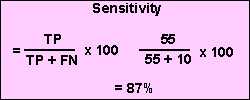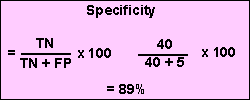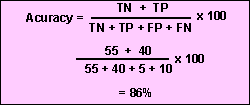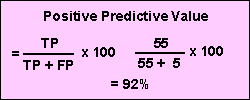Statistics Behind the Exam
- When ever a patient undergoes a medical exam, there are probabilities associated with the accuracy of its diagnosis. If an exam is very accurate and its results are positive or negative, then with a high degree of confidence you are assured that the results are correct. However, this is not always the case, so let us explore this realm of exam accuracy.
- Basic terms
- If the exam does not show disease it is considered negative
- If the exam does show the disease then it is positive
- With the two basic terms there are four possible outcomes/variables and they are:
- True positive (TP) occurs when the positive exam really is positive
- False positive (FP) exam occurs when positive exam is really negative
- True negative (TN) is an exam that is truly negative
- False negative (FN) occurs when the negative exam is actually positive
- So let us look at an example on how this works .. What if a patient has a bone scan for the diagnosis of metastatic disease. Once the results of the bone scan is know there are for possible outcomes: TP, FP, TN, or FN.
- Now let us assume that there is a population of 110 patients that underwent an MPI procedure to determine if he/she had CAD:

- From the 110 patients the results indicate that all is not black and white. In the mix of positive and negatives that have the four variables mentioned earlier. The question that now has to be asked is how does one report the above data? There are several factors to look at and there are discussed below.

- Sensitivity or the true positive fraction is one aspect of determining the amount of TP in the study of 110 patients. This value determines that amount of patients that where diagnosed with ischemic heart disease really had ischemia. In this case sensitivity it's 87%. Another way to express this is to state that this is a percentage or fraction of patients that had a positive diagnosis.

- Specificity, also known as the true negative fraction determines the amount of TN in this given population or the percent/fractions of patients that really did not have ischemia. In this example 89% of the patients are truly negative.

- Accuracy is the yet another term used to describe our diagnostic evaluation of 110 patient. This calculation combines specificity and sensitivity or another way stated is to say that the number of represences the correctly diagnosed divide by the entire population.

- PPV or positive predictive value is expressed above. More clearly stated it is the percent or faction of individuals who's tested positive for disease, really have disease. Hence, the study of this population reveals that 92% of the time a positive scan will be positive.

- NPV or negative predictive value which is seen above and stands for all persons with a negative test value that are really negative. In the example that we have hypothetically developed the value is 80%. This means that if a patient were to have a bone scan to detect metastatic disease and the results were negative, then there is an 80% probability that it really is negative.
- From the data above one could argue that in the study of diagnosing metastatic disease using whole body bone imaging and the values generated could represent an even larger population of patient with similar sensitivity, specificity, accuracy, PPV and NPV. In fact,when research is done on any radiopharmaceutical and data is collected as to its ability to diagnose disease, these values mentioned are always used.
- Bayes' theorem is yet another concept that actually affects the probable outcome of a study. The application will be used with nuclear cardiology
- Two questions must first be considered
- What is the probability of the patient having disease if the results are positive?
- What is the probability of the patient not having disease if the results are negative?
- Initially determine the pre-test likelihood of disease - setup parameters
- Asymptomatic
- Chest pain = substernal location, provocation by exercise, and pain relief via nitroglycerin
- Typical angina = all the
- Atypical angina = two of three
- Non-angina = one of three
- Pretest likelihood of disease affects the post-test likelihood of disease
- In an asymptomatic patient, pretest probability of having diseases is 5%. The results then indicate only 20% that have a positive stress test are truly positive, while less than 1% of the negatives are false negative
- In classifying those patients with an intermediate likelihood of CAD the pretest probability is 50%. [post test] Of those patients that have a positive test, 90% will be true positives, while those that are negative have less than 10% of being false negative
- High pretest likelihood (typical angina) of CAD has a 90% likelihood of disease. [post test] Of those that are positive 99% are true positive, while of those that have a negative scan, 75% are false negative
- Conclusion:
- Does a nuclear cardiology exam benefit patients with low probability of disease?
- When should nuclear cardiology be ordered on a patient?
- Of the classifications above, which group of patients receives the most benefit when Bayes' theorem is applied?
- What is the value of taking a patient's history?
![]()




